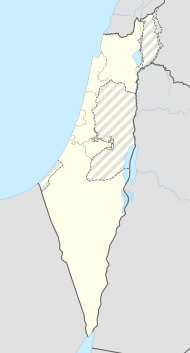Dalja
| Dalja | ||
|---|---|---|
| Basic data | ||
| hebrew : | דליה | |
| State : |
|
|
| District : | North | |
| Founded : | May 1, 1939 | |
| Coordinates : | 32 ° 35 ' N , 35 ° 5' E | |
| Height : | 204 m | |
| Residents : | 801 (as of: 2018) | |
| Community code : | 0300 | |
| Time zone : | UTC + 2 | |
| Postal code : | 19239 | |
| Website : | ||
|
|
||
The Kibbutz Dalijja ( Hebrew דַּלִיָּה Dalijjah , German 'tendril' ) is located in northern Israel on the edge of the Jezreel plain in Galilee on the southeastern foothills of the Carmel Mountains and about 30 km southeast of Haifa . It emerged in 1939 from the two former kibbutzim Bama'ale and Bamifne . The name of the kibbutz goes back to the former Arab village of Dalijat-el-Rucha, whose land was acquired from Arab landowners by the Jewish National Fund . At first the population consisted of 160 adults and 14 children, in 2018 the population was 801. Today the kibbutz is known for its soap and chemical production ; he owns a few holiday homes for guests and there are Israeli folk festivals.
history
prehistory
Kibbutz Dalja was created through the merger of two kibbutzim that were related to HaSchomer HaTzair (an international socialist - Zionist youth organization). The first kibbutz Bama'ale consisted mainly of immigrant members from Romania , particularly Transylvania , many of whom had agricultural or industrial training. The first of them reached Israel in 1933 , but had to wait for permission from the Jewish Agency to be allowed to settle permanently. The second Kibbutz Bamifne in Karkur consisted of German members. Some of these were trained in agriculture in Denmark , but many of them had studied in Germany , France or England . This kibbutz was also founded in 1933. Its members mainly worked in agriculture, as construction workers in the nearby village of Gan HaSchomron or as dockworkers in Haifa.
On April 26, 1939 it was decided to merge the two kibbutzim Bama'ale and Bamifne and on May 1 of the same year Dalja was founded in Ramat Menasche.
Development of the kibbutz
Dalja was founded as one of the last tower-and-palisade settlements with 160 adult members and 14 children. Stony, dry ground and a single well in the former Arab village created difficult starting conditions, but they could be overcome. Small plants for soap and detergent production as well as a factory for water meters were built, which made Dalja one of the first kibbutzim with industrial production. The Hag Habikurim dance festival , a kind of harvest festival , originated here and quickly gained popularity. In 1947 tens of thousands of spectators came from all over Israel to see several hundred dancers. In 1950 a new well was drilled, which ensured access to larger water resources. Around 600,000 m² of pine , cypress and carob trees were planted.
The state water company drilled directly at the kibbutz in 1950 and came across large water reserves at a depth of 374 m, which allow a production of 300 m³ of water per hour. Further drilling followed and changed agriculture, chemical production and the lives of the residents considerably. The chemical industrial plant "Zohar Dalia" is still one of the most important in Israel, even if it is struggling with modernization problems. The population of the kibbutz is steadily decreasing slightly.
Web links
- Kibbutz website (English, Hebrew)
- Website by Zohar Dalia
Individual evidence
- ↑ אוכלוסייה ביישובים 2018 (population of the settlements 2018). (XLSX; 0.13 MB) Israel Central Bureau of Statistics , August 25, 2019, accessed May 11, 2020 .
- ↑ אוכלוסייה ביישובים 2018 (population of the settlements 2018). (XLSX; 0.13 MB) Israel Central Bureau of Statistics , August 25, 2019, accessed May 11, 2020 .


